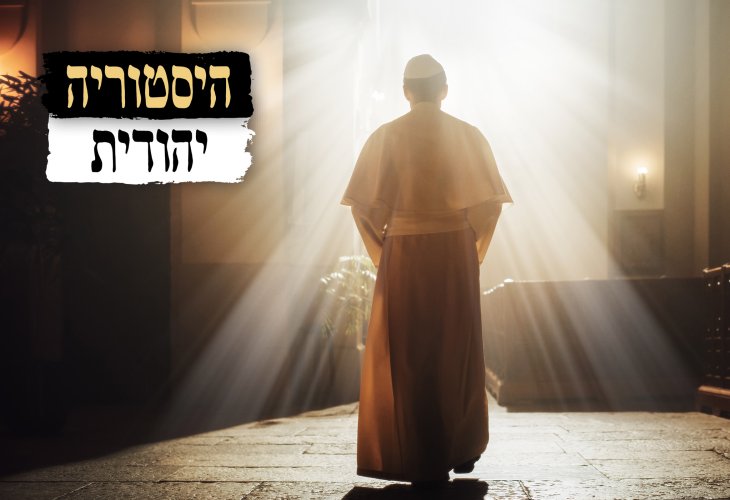A Moment in History: The Jewish Stand Against the Pope
A group of Jews remained trapped in the dungeons of the Inquisition, with an evil Pope decreeing their fiery execution. Could the leaders of the time thwart his wicked plan?
 (Illustrative photo: shutterstock)
(Illustrative photo: shutterstock)The year was 1556. In a grand palace at the heart of Constantinople's old city, known to Jews as Kushta and now Istanbul, a significant gathering took place in one of its opulent halls: Hannah, the lady of the house; an army of servants, attending to each guest with fine refreshments; several rabbis from the city of Kushta; and two notable leaders of the generation: Rabbi Yosef Caro and Rabbi Yosef ben Lev.
Hannah Nasi, better known as Doña Gracia Nasi, began: "Esteemed rabbis, as you know, the wicked Cardinal Caraffa was appointed pope last year under the name 'Paul IV.' This villain breached the agreement his predecessor, Paul III, had made to protect the Sephardic community that had fled from Portugal to Ancona, Italy. Last Av, he issued fourteen decrees against the Jews in Italy, imprisoned all the Jews of Ancona in the Inquisition's dungeons, and on the 9th of Av, 1555, he confined the Jews of Rome to a ghetto, forbidding them to leave. Now, he threatens to burn alive the Jews of Ancona. I seek your counsel on how we might prevent these tragedies."
Doña Gracia was no ordinary Jewish woman; she was considered the wealthiest woman in the world and wielded significant economic power in the Ottoman Empire of Sultan Suleiman, who regarded her highly. Although Suleiman sent warnings to Pope Paul IV, the Pope acted irrationally, driven by his deep-seated hatred.
The Nasi family also wielded considerable influence over the French crown, which relied on substantial loans from the Mendes bank, owned by the family. The French ambassador, Codignac, rushed to Rome, attempting to influence the pope. Banks and businessmen, diplomats, and emissaries from across Europe confronted the pope with economic threats that could spark wars. Ultimately, the pope was forced to release any Jew linked to the Ottoman Empire, France, or other involved parties.
Yet, a group of Jews remained trapped in the Inquisition's dungeons, with the evil pope ordering them to be burned alive. Every few days, a number of Jews were taken to the city square and burned. Historian Yosef HaKohen, a doctor from Avignon, recounts: "This evil Titan poured his wrath upon the Anusim in Ancona, burning about forty people and an elderly woman in Sivan of Ancona. As they perished, they recited 'Shema Yisrael,' and their pure souls ascended in the flames to the heavens."
Doña Gracia continued: "Beyond the 24 martyrs sanctifying Hashem's name, Paul sentenced another 27 people to a lifetime of hard labor, including Yaakov Moro, a key agent of the Mendes Bank. We cannot stand idly by; I request your permission to propose a worldwide Jewish boycott of the Ancona port. The Anconian authorities impose a hefty tax on every ship docking at their large and advanced port, but henceforth, no Jewish ship shall stop there. This will cause an immediate 40% reduction in Anconian revenues."
Several city merchants interjected: "This is impossible," "My livelihood depends on goods sold in Ancona’s markets. Must I now beg?" Yet, Doña Gracia had prepared an alternative business plan: merchant ships would instead dock at the Pizarro port. This plan was coordinated with Jewish merchants in Pizarro, thrilled by the business opportunity and the chance to avenge Ancona’s rulers and the evil pope. Pizarro’s prince, Urban Guido Obaldo, also wished to join the fight against Ancona for his own reasons.
The debate was complex and lengthy. All awaited the decision of the era's great rabbis, the "Beit Yosef" and Maharibal. After lengthy discussions, the two rabbis conferred quietly before announcing unanimously: We cannot support a halachically binding boycott since we lack the authority to compel all Jews to comply. However, we believe a voluntary economic boycott, agreed upon by merchants, is appropriate to harm and punish the people of Ancona and their wicked ruler.
Doña Gracia, her son-in-law Don Yosef Nasi—the Duke of Naxos—and the house of Mendes were delighted with the rabbis’ approval, especially that of Rabbi Yosef Caro, who was highly respected by all of Israel, and they set out to implement the boycott.
Yet beyond the Black Sea, different opinions arose. Rabbi Moshe Basola of Ancona believed that despite the desire for revenge, the boycott would endanger Ancona's Jews and possibly all Italian Jews. In an urgent letter to Kushta, he wrote: "Such agreement will be like thorns for all Jews under Papal rule as his wrath will blaze against the People of Hashem..."
The Ancona boycott debate stirred, unfortunately, a rift among Jewish communities, a turbulent and challenging disagreement. Not all Jewish communities joined the boycott, but those that did managed to deliver a significant blow to Ancona, particularly the Jews of Kushta, a formidable maritime commercial power at that time.
We have no precise reports on Ancona's losses during the partial boycott, but it clearly dealt a significant blow, causing notable losses. Fortunately, Pope Paul IV died within three years, making the debate moot before a resolution could be reached. Regardless, the Ancona port never regained its former glory.
Italy eventually celebrated Paul IV's demise. In Rome, the populace rejoiced with four days of riots, tearing down the mad pope’s statue, throwing its fragments into the Tiber River. The crowd burned the Inquisition buildings and all documents containing "incriminating" information about citizens, freeing prisoners, and Europe breathed a collective sigh of relief. Yet, Jews did not find freedom from exile's burden with one madman’s death. The Inquisition continued its oppressive hold, pushing Doña Gracia and Don Yosef to their next initiative: renewing settlement in the Land of Israel. More on this in a forthcoming article.

